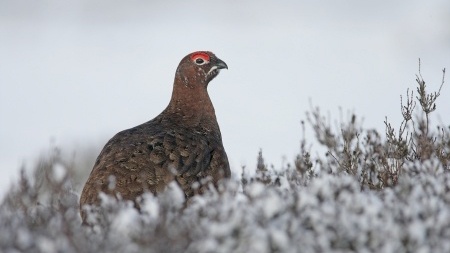As another grouse shooting season begins, research out today (Tuesday August 12) in the British Ecological Society's Journal of Applied Ecology shows ecology could help break the decades-long deadlock between grouse shooters and conservationists seeking to protect hen harriers on UK moorlands.
Led by Professor Steve Redpath of the University of Aberdeen, the study involved grouse managers and conservationists as well as ecologists. Using science as a way to seek solutions to the conflict, the grouse managers and conservationists together agreed key questions they wanted the research to answer. The ecologists then developed a model to explore a possible compromise solution.
The model showed that at certain population densities, harriers can co-exist with profitable grouse shooting. According to Professor Redpath: “The model suggested that across the grouse moors of England there was room for 70 pairs of hen harriers at relatively low cost for grouse shooting.”
This could be achieved using a simple approach, where when harriers breed at levels that have a significant economic impact on grouse shoots, the excess chicks would be removed from the grouse moors, reared in captivity and then released into the wild elsewhere. Similar schemes are used in continental Europe where harriers breeding in crops are threatened by harvesting.
The next step is for grouse managers and conservationists to use the results of the model to agree on an acceptable number of harriers and then test the idea in a field trial.
The standoff between grouse managers and hen harrier conservationists is one of the UK's most bitter and contentious wildlife conflicts. Grouse managers want to maximise the number of birds available for shooting, and see any predation by hen harriers as a threat. Hen harriers eat grouse and are illegally killed, so despite being legally protected the birds have all but disappeared on moorland managed for intensive grouse shooting. There were no breeding harriers in England in 2013.
Grouse moor management has benefits for biodiversity and for communities. The question, however, remains as to how the illegal killing can be stopped without losing these benefits. A quota scheme provides a possible solution.
“Any decision about how to use this model depends as much on politics as on science. However, if both sides are interested in pursuing the idea, this model provides a framework for this dialogue to take place,” says Professor Redpath.
Despite polarised positions and lack of trust, the research shows that by involving both parties and testing the effectiveness of various solutions, ecology can help resolve wildlife conflicts – which can have dramatic impacts on people's lives and livelihoods – worldwide.
“Ecology has a vital role to play in understanding and tackling these conflicts by providing impartial evidence and exploring various technical solutions. However, this must be done with those involved in the conflict so that science addresses the issues people are most concerned about, and that they therefore have ownership of the results,” he says.
David A. Elston, Luigi Spezia, Dave Baines and Stephen M. Redpath (2014). “Working with stakeholders to reduce conflict – modelling the impact of varying hen harrier Circus cyaneus densities on red grouse Lagopus lagopus populations”, doi: 10.1111/1365-2664.12315, is published in the Journal of Applied Ecology on 12 August 2014.


